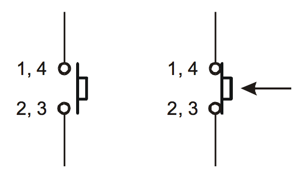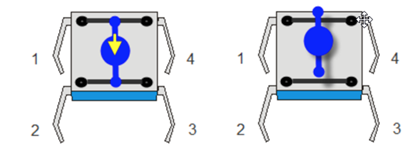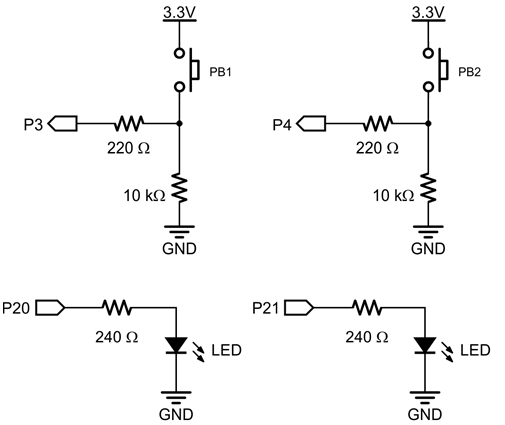Many items you use every day have pushbuttons. Cell phones, microwave ovens, TV remotes, and computer keyboards might all have pushbuttons. Can you think of others?
Let's use a common pushbutton circuit and build a program for monitoring it with your microcontroller. Then, let's use a pushbutton's state to control LED circuits. LEDs are just one example of a device you can turn on and off with a microcontroller. Your invention might instead use pushbuttons to control circuits for motors, heating elements, or other devices.
The micro:bit module has two built-in pushbuttons. You can also add more pushbuttons to your cyber:bot on the breadboard. Doing so, you will learn how a pushbutton circuit works.
About Pushbuttons
A pushbutton is a device that makes an electrical connection between two of its terminal leads when its button is pressed. When the button is released into its normally-open state, the electrical connection is broken and no current flows through the device. Here is the schematic symbol:

...and here is a drawing that resembles a breadboard-friendly pushbutton:

Notice that when the button is pushed, all 4 pins are connected. However, when the button is not pushed, legs 1 and 4 are still connected and legs 2 and 3 are still connected.
If the pushbutton is pressed, the circuit applies 3.3 V to the I/O pin through the pushbutton, and a small amount of current also passes through the 10 kΩ resistor to ground. When the pushbutton is not pressed, the connection to the 3.3 V supply is broken, and so the circuit applies GND (0 V) to the I/O pin.
Pushbutton and LED Circuits
This circuit uses your board's built-in P20 and P21 LEDs, along with two pushbutton circuits you will build onto your breadboard. Use 220 ohm resistors to connect the pushbutton circuits to the cyber:bot I/O pins and use 10 k-ohm resistors to connect the circuits to ground.
Parts
(2) pushbuttons
(2) 220 ohm resistors (red-red-brown)
(2) 10 k-ohm resistors (brown-black-orange)
- Make sure the cyber:bot board's PWR switch is set to 0.
- Build the two pushbutton circuits shown in the schematic and wiring diagram. We are also using the built-in LEDs on P20 and P21.


Test script: test_pin_3_button
This test script will display the state of the button connected to P3 on the micro:bit module’s display. The display will show a 1 if the button is pressed, or 0 if it is not pressed.
- Open a script you have previously used with the cyber:bot baord, like one of the light blinking scripts or cyberbot-template-with-blink.hex.
- Set the project's name to test_pin_3_button, update the script so that it matches the one below, and then click Save.
- Click Send to micro:bit.
# test_pin_3_button
from cyberbot import *
while True:
if bot(3).read_digital() == 0:
display.show("0")
elif bot(3).read_digital() == 1:
display.show("1")
- Set the cyber:bot board's PWR switch to 1.
- Verify that the 5x5 LED matrix display shows 0.
- Press and hold down the pushbutton connected to P3.
- Verify that the 5x5 LED matrix display shows 1
If the micro:bit did not display 1 when the button was pressed and held, or if it did not display 0 when it was not pressed:
- Check your circuit and script for errors and try again.
- Keep checking, fixing, and retesting until it works as described.
How test_pin_3_button Works
This Python script is all inside of a continuous while True: loop. Inside the loop there is one if statement that checks two conditions.
The first condition that it checks is whether the bot(3).read_digital function is equal to 0. If this is true the micro:bit module will display a 0. The read_digital function checks the input state of the pin, in this case P3. Thus, if the button is not being pressed, the input state at pin 3 is 0.
The second part of the if statement checks to see if the input state is 1 (button pushed), if so the micro:bit module will display a 1.
Did You Know?
Active-high: The pushbutton circuit you are using is called active-high because the pushbutton sends the cyber:bot I/O pin a 3.3 V high signal when pressed (active) or a 0 V low signal when released.
Pull-down: The 10 k-ohm resistor in the schematic is called a pull-down resistor. It’s there so that the I/O pin will detect 3.3 V through the resistor when the button is pressed. If you leave it out, the I/O pin behaves more like an antenna, and nearby electric fields will end up controlling whether 1 or 0 is detected.
Active-low, pull-up: Pushbuttons circuits can also be active-low. All you have to do is swap the pushbutton and 10 k-ohm resistor in the schematic. The pull-down resistor then becomes a pull-up resistor, and the I/O pin will detect 0 V when the button is pressed.
Try This: pin_3_button_LED
Now it is time to control an LED with a pushbutton.
- Set the project's name to pin_3_button_LED.
- Change # test_pin_3_button to # pin_3_button_LED.
- Change the display.show functions to the bot(20).write_digital() method to turn on the P20 yellow LED attached to pin 20 while the button is being pressed.
- Change display.show("0") to bot(20).write_digital(0) and change display.show("1") to bot(20).write_digital(1).
- Click Save, and then click Send to micro:bit:
# pin_3_button_LED
from cyberbot import *
while True:
if bot(3).read_digital() == 0:
bot(20).write_digital(0)
elif bot(3).read_digital() == 1:
bot(20).write_digital(1)
- Verify that the P20 LED blinks while you press and hold down the pushbutton connected to P3, and turns off when you release it.
Your Turn - P21 LED and P4 Pushbutton
Can you make the LED connected to P21 light when the button connected to P4 is pressed?
- Modify your Try This project to test controlling the P21 LED with the P4 pushbutton.
- Save the project, and expand the code so that the P3 button controls the P20 LED and the P4 button controls the P21 LED at the same time.
If You Are Done
If you are done for the day, always follow these steps.
- Set PWR to 0.
- Unplug the battery holder's barrel plug from the cyber:bot board's barrel jack.
Just taking a break, but will do more today? Then follow these steps.
- Just set the cyber:bot board's PWR switch to 0 until it's time to test the next script.
